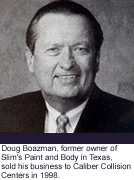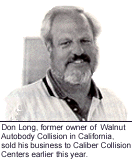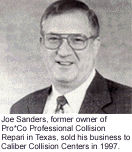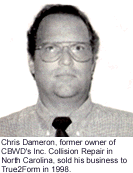One of the hot issues in the collision repair industry — also a hotly debated issue — is consolidation and what effect it will have on the industry.
For some, consolidation is seen as inevitable and represents an exciting opportunity to explore a vision and direction for the future. Others, however, say consolidation is mainly hype and hoopla — that it’s just another fad and will pass without any substantial changes to the industry; they believe, among other things, the industry is too unique to fall prey to a "McDonald’s" or "Home Depot" style of business model.
Should collision shop owners across America re-think their business strategies, or is consolidation something that will affect only the largest markets and not be a big deal for the average shop?
What, specifically, consolidation means to this industry has yet to be determined; what has been determined is that — based on other industries that have gone before us — consolidation isn’t an issue to be taken lightly.
To find other successfully consolidated industries, we don’t have to look far:
• In the retail-trade sector, the drug store industry was altered completely when companies such as Walgreen’s, CVS and Eckard’s consolidated and replaced the traditional pharmacy located downtown in just about every town in America.
• As a result of consolidation, mega-stores such as Home Depot and Lowe’s have nearly wiped out the family-run hardware stores and now dominate the hardware industry.
• It wasn’t that long ago that you ran to your locally owned auto parts store to buy parts to fix your car. Now, PEP Boys, Parts America, Chief and Auto Zone have taken huge shares of that marketplace.
• In 1985, there were 23,000 banks and savings and loans in America. Today, there are less than 12,000. That represents a consolidation of nearly 50 percent.
The Benefits of Consolidation
Consolidation occurs by combining outlets to replace a multitude of smaller providers into a larger and more efficient organization. The driving forces are usually tied to efficiency gains, consistency, economies of scale, cost reduction and cycle time. And the search for these efficiencies drives the pace of competition among a new breed of competitors.
Let’s take a quick look at the potential benefits of consolidation as they could apply to the collision repair industry:
• Administration has always been a difficult expense to control in a small collision shop. In a consolidated business, however, it can be spread over more shops with a much larger revenue base.
• Multiple locations in a single market offer the opportunity to develop market presence and allow for more efficient marketing of the collision centers.
• Increased volumes generate a higher profile with insurance companies. Consolidation "could be a great deal for insurance companies," Jayna Neagle, a spokesperson for the Insurance Information Institute, was recently quoted as saying in USA Today. "Insurance companies want to deal with one [repair] entity in the majority of states where they do business. They can get consistent quality, and it makes it a lot easier than dealing with thousands of independent shops."
• Larger organizations should be able to invest the resources to develop and refine more efficient production scheduling and workflow management techniques to improve efficiency at every level of the shop, which should improve cycle time.
• As the materials-purchasing volumes increase for the collision centers, it should enable them to explore the most advantageous pricing for both OEM and aftermarket parts, as well as any other supplies needed for the organization.
• Consolidators will likely be perceived as being more stable and offering better opportunities with more attractive benefits packages and competitive salary structures, which will attract and keep the best technicians.
• Greater technician population should give rise to opportunities to improve labor efficiency through the use of "graduated skills level" technicians within the repair process.
• Larger organizations will be able to justify a significantly more focused management team who can implement sophisticated internal tracking systems to monitor the pace and direction of the operations of the collision centers.
• And the list goes on …

The Players
Consolidation of the collision repair industry began in earnest in 1998, causing the pace of buying and selling collision centers to significantly increase. Why did it begin? Because the collision repair industry represented one of the few remaining opportunities for aggressive consolidators to pull together groups of privately held businesses and build them into much larger, multi-location corporations on an unprecedented scale.
Until the last few years, a collision repair center that had repair volume in excess of $5 million was the exception, with 91 percent of the shops having revenues less than $1.5 million. But the consolidator’s goal is to build organizations that are significantly larger. We’ve already seen organizations created that will have volumes in excess of $75 million, and they’ve only just begun to build. In just the last two years, at least 12 significant consolidators have emerged (and the growth has been so fast that there are probably others I’ve missed).
Who are these consolidators?
• ABRA Auto Body and Glass, LLC, headquartered in Brooklyn Center, Minn., has 70 company-operated repair facilities in 12 states. Rollie Benjamin, president and CEO, plans to have 200 facilities by the year 2000.
• The Boyd Group, already the largest operator of collision repair shops in Canada, operates 40 company-owned stores and 14 affiliates in both Canada and the United States. The company estimates its 1999 revenues at $55 million.
• Caliber now holds 24 company-owned stores and a network of 120 locations in California and Texas. Its revenue base from just the company-owned stores is likely more than $85 million.
• CARA Collision and Glass was founded by Randy McPherson (co-founder of ABRA) in September 1996 and consists of 26 stores.
• CARSTAR, at last count, had nine company-owned stores as compared to six a year earlier, and its recently announced company-owned store development plan calls for adding more than 200 facilities during the next five years. CARSTAR has declined on the franchise side to 250 but clearly has the largest number of independent collision repair sites. CARSTAR Canada includes 60 stores.
• CollisionMax, the repair arm of the fleet and insurance-claims management firm CEI, operates nine locations in Pennsylvania and New Jersey and is looking for other acquisitions east of the Mississippi.
• Collision Team of America (CTA), the former Church Brothers operation based in Indianapolis, was formed in 1998 and now has 44 stores in Florida, Illinois, Indiana and Texas.
• Gerber Auto Collision and Glass, a third-generation family-founded business based in the Greater Chicago area, operates 13 locations in Illinois, Minnesota and Wisconsin.
• M2 Collision Centers operates 25 stores in California and Nevada, and this year opened a brand new, 35,000-square-foot facility in San Diego with another "greenfield" planned.
• Sterling Collision Centers, Inc., formerly known as CarQuarters, operates 32 locations in six states — up from the one it had 18 months ago. Jonathan McNeill formed Sterling in September 1997.

The Deals
Up to this point, existing players within the industry are leading the consolidation effort and have developed their particular vision of a successful consolidation strategy, which among other things, will involve acquiring additional locations to expand into new and adjoining markets. The ideal target acquisitions are successful, well-established, well-managed collision centers with a significant market share. For example, the earliest transactions involved some of the premier collision repair shops in the country, such as Collision Team of America’s (CTA’s) acquisition of Church Brothers and Alamo. In this example, the consolidations aren’t necessarily geographically linked to each other — and don’t need to be — because the purpose of acquiring them is to establish a platform in each geographical market. After the platform is established, additional acquisitions will be targeted to fill the gaps in the market.
So far, the deals have been either a business combination or a sale of the business:
• A business combination is where the target business owner places his assets and liabilities into the acquiring company and takes a share in the equity of the resulting company as his compensation. It’s a trade of equity for equity.
Since a business combination doesn’t drain the cash of the acquiring business, it initially can be a preferable method to grow. One of the unfortunate results of a business combination is that the existing shareholders have their ownership position diluted by the inclusion of new shareholders. And, at some point in time, the acquisitions will need to be structured as sale.
• In a purchase of a business, the value of the business is based on factors such as sales, equipment and location. The purchase is funded with cash and a seller-carried note. The seller realizes a percentage of value in cash up front, and the rest of the value is paid over a number of years. Consolidators try to structure the deals to have between 30 to 40 percent cash. The cash portion may be provided from existing cash of the acquiring business, through borrowed funds from a lending institution or from cash raised through a sale of a portion of the acquiring company to an investor.

Why Such Rapid Growth?
The common wisdom within the industry was that there weren’t many consolidators with huge cash positions to fuel a rapid consolidation, and the prospect of borrowing enough cash from a bank was equally unheard of. Typically, bankers are interested in lending money only to the extent that you had hard collateral, such as equipment or real estate. But most businesses sell at a value much greater than the value of the equipment.
The bottom line: To be a consolidator takes cash — and lots of it.
Enter private equity. An investor, usually in the form of an investment bank, venture capital fund or private investor, invests significant amounts of cash into the consolidator’s company. In return, he gets a piece of the company and some level of control. Until three years ago, the prospect of some Wall Street investor teaming up with a body shop owner was incomprehensible. Who would put up the money to back a dream of becoming the "King of Body Shops"? The dollar amounts that were dreamed about were in the hundreds of thousands of dollars. And they were just that — dreams. But there were a few who had the dream, the vision and the drive to put it all on the line.
Now fast forward to today; the equity-investment dollar amounts are impressive:
• True2Form began its expansion with $10 million in venture capital from Bankers Trust Capital Partners.
• ABRA has the backing of GE Capital Corporation and Firemark Advisors, Inc.
• The Boyd Group, Inc. has entered into arrangements with BASF that could provide the company with $17 million in equity infusion.
• CARSTAR has partnered with Equity South.
• Sterling attracted $25 million in venture capital from the investment firms Conning and Berkshire Partners.
• Caliber Collision Centers, Inc. started its expansion with an equity injection of $20 million from Keystone, Inc. and Zurich Centre Investments Limited.
• CTA was originally fueled with venture capital from Saugatuck Capital, which raised more than $75 million for the purpose of consolidating the industry. CTA then added Ford Motor’s Customer Service Division as a minority investor last summer.
• M2 recently announced it had completed a $90 million debt and equity financing involving Blue Capital Management, Chase Capital Partners and Heller Financial, Inc.
Watching venture capital is the closest thing you can have to a crystal ball. Experts say this form of investment, normally reserved for savvy institutional investors and high-net-worth individuals, often acts as a leading indicator of what lies ahead for an industry. And they say by monitoring the venture-capital industry’s latest investment picks, you’ll also gain valuable insight into which sectors and players will be hot in the months and years to come.
The venture-capital deals above cover just eight of the 12 identified players. If we assume these eight are representative of the rest, then we can reasonably figure that in the last two years, somewhere in the neighborhood of $500 million has been invested with the goal of consolidating the collision repair industry.
At this pace, it’s not hard to imagine that consolidators could have about 30 percent of the market in five years, up from about 8 percent today. It’s also been suggested that consolidators could perform 80 percent of the collision repair work in the nation’s major markets.

OEMs and Their Dealerships
When asked about their decision to invest in CTA, Peter McIntosh of the Ford Customer Service Division he said: "We believe the consolidators are going to grow rapidly. In a couple of years, there may be a few very, very large ones that control a big piece of the business. In effect, some of our destiny could be controlled substantially by other people."
General Motors has embarked on its own internal project to acquire knowledge about the industry from within service-parts operations, but there will be some catching up to do since dealerships and manufacturers have literally handed over the business to the independent collision centers during the last three decades. But, let’s face it, because dealerships have been involved in their own consolidation efforts, it’s only a matter of time before their focus turns to formulating the best strategies for positioning their collision centers.
(Currently, the largest chain of company-owned collision repair centers in the United States is owned by the automotive retail consolidator, Republic Industries, Inc. But Republic wasn’t looking to consolidate the collision industry; it simply accumulated a lot of body shops as a result of consolidating automotive dealerships. What it does with all its shops will be interesting to follow.)
Because dealers continue to be pressed to improve returns on each and every department in the dealership, a collision center continues to be an opportunity to develop additional revenue at attractive margins. The number of Ford dealers with collision repair facilities is about 1,735 out of 5,000 dealerships, while GM has a little more than 4,000 out of approximately 8,500 dealerships.
It’s hard to imagine that, with this level of investment, dealers will just give up on the collision industry. Granted, some will exit, but others have found their collision centers to be a valuable contributor to their bottom lines.
The Future
The investors backing each of the players in the consolidation of the industry believe their team can produce a business model that will deliver the critical components of success: quality, improved cycle time and cost reduction. If they succeed, this will raise the bar for the collision centers remaining in the industry and forever alter how nearly every shop in the United States and Canada operates.
Don’t think consolidation will have much of an impact on the industry or on your shop? Maybe you’re right. But the half a billion dollars that’s been invested so far to consolidate this industry says you’re wrong.
Writer Thomas Speed is a Financial Markets Specialist at Edwards & Associates Consulting, Training and Research in Charlotte, N.C. Speed can be reached at (800) 979-9904.













